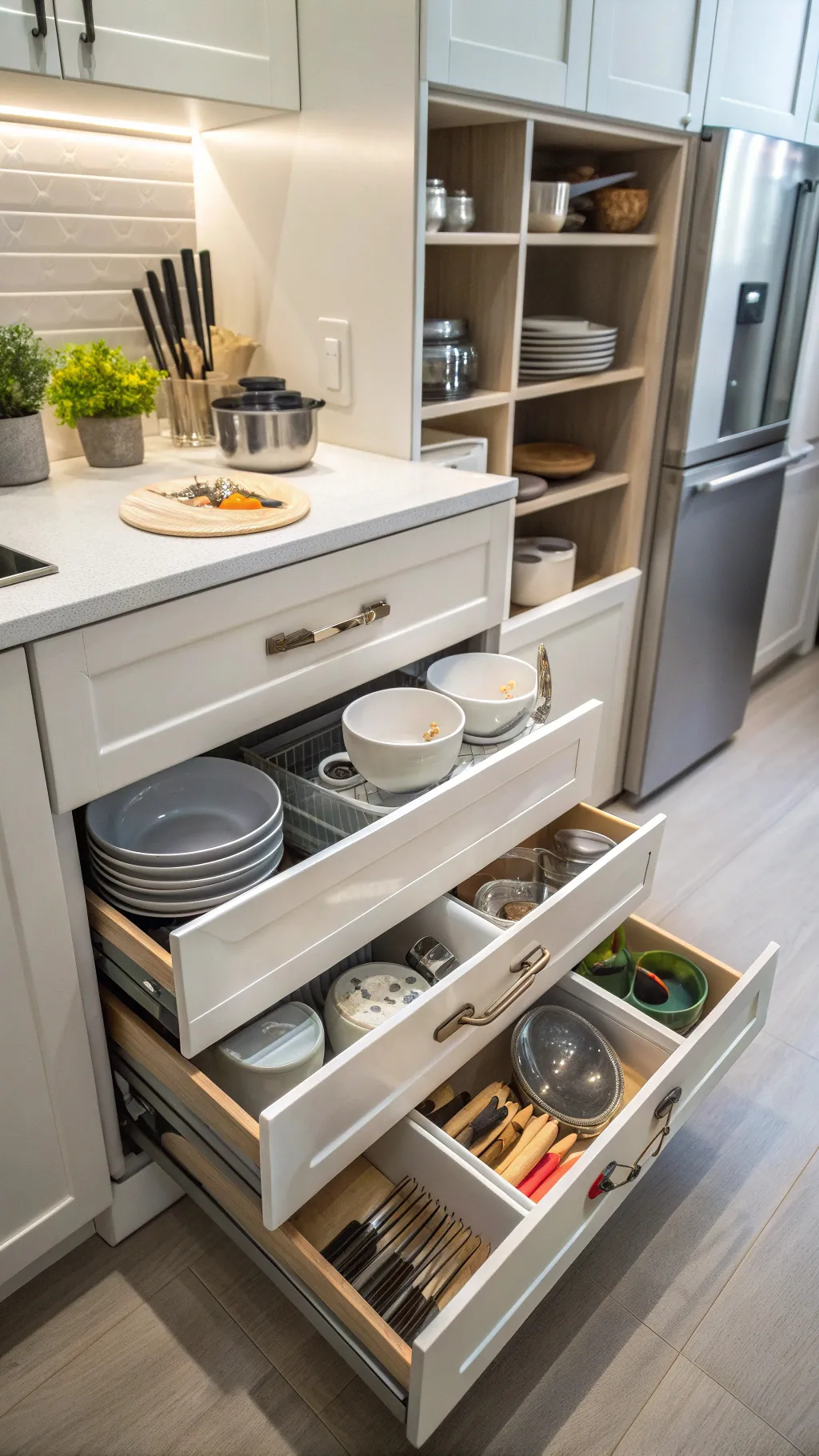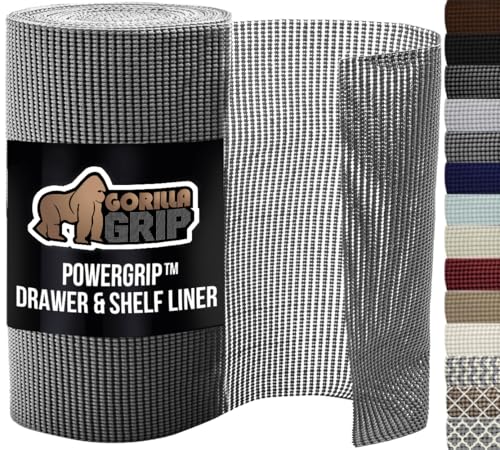In this comprehensive guide, I’ll share my best strategies for organizing kitchen cabinets and drawers that will transform your cooking space from chaotic to calm.
You’ll discover exactly where to place items for maximum efficiency, learn smart storage solutions for every kitchen size, and find out how to maintain organization for the long term.
Let’s dive in…..
In This Article
- 1 The 7-Step Process for Kitchen Cabinet Organization
- 2 Step 1: Empty and Declutter Everything
- 3 Step 2: Clean Your Cabinet Interiors
- 4 Step 3: Categorize Your Kitchen Items
- 5 Step 4: Plan Your Kitchen Zones
- 6 Step 5: Implement Storage Solutions
- 7 Step 6: Put Everything in Its Place
- 8 Step 7: Label and Maintain
- 9 Strategic Cabinet Zoning: What Goes Where
- 10 Upper Cabinets: What to Store Here
- 11 Lower Cabinets: Optimal Organization
- 12 Drawer Organization Systems That Work
- 13 Organizing Kitchen Cabinets in a Small Kitchen
- 14 Maximize Vertical Space
- 15 Multi-Functional Storage Solutions
- 16 Create an Appliance Garage
- 17 Smart Pantry Cabinet Organization
- 18 Categorize and Contain
- 19 Create Accessible Zones
- 20 Specialized Storage Solutions
- 21 Pot and Pan Organization
- 22 Spice Storage Systems
- 23 Smart Solutions for Awkward Spaces
- 24 Maintaining Your Organized Kitchen
- 25 Weekly Reset Routine
- 26 Seasonal Organization Updates
- 27 FAQs: Kitchen Cabinet Organization
- 27.1 Where should dishes and glasses be stored in kitchen cabinets?
- 27.2 How do I organize my kitchen cabinets if I’m left-handed?
- 27.3 What’s the best way to organize under the kitchen sink?
- 27.4 How do I maintain organization with roommates or family members?
- 27.5 What should I do with rarely used small appliances?
- 27.6 How do I organize a kitchen with very few cabinets?
- 27.7 What’s the best way to organize food storage containers?
- 28 In the End….
The 7-Step Process for Kitchen Cabinet Organization
Before jumping into what goes where, let’s establish a systematic approach to organizing your kitchen cabinets.
Step 1: Empty and Declutter Everything
I always start by completely emptying all cabinets and drawers. Set up three piles: keep, donate/sell, and trash. Be ruthless with items you haven’t used in over a year—duplicate kitchen gadgets, mismatched containers, and chipped dishes should go.
This decluttering phase is crucial for creating space and identifying what you actually need to organize.
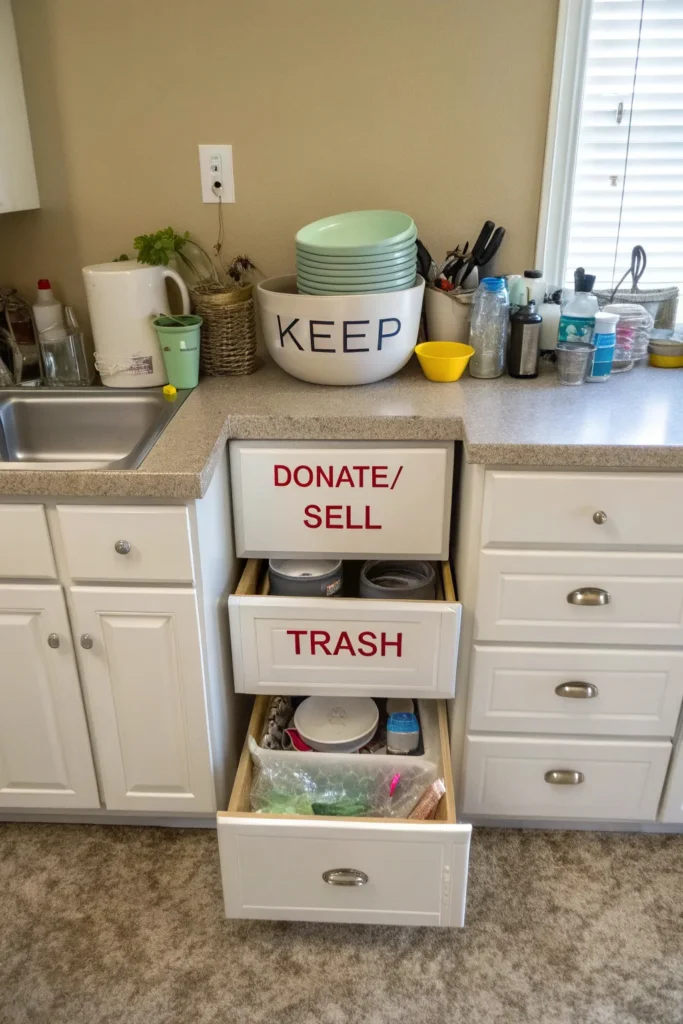
Step 2: Clean Your Cabinet Interiors
Once everything is out, I take the opportunity to wipe down all cabinet and drawer interiors. Use a gentle cleaner to remove crumbs, spills, and dust that have accumulated. Consider adding shelf liners to protect surfaces and make future cleaning easier.
This fresh start will make your newly organized kitchen feel even better.
Step 3: Categorize Your Kitchen Items
I organize items by both type and frequency of use. Group similar items together: cooking utensils, bakeware, food storage containers, etc. Then further divide by how often you use each item.
This dual-categorization approach ensures you’ll put frequently used items in the most accessible places, while seasonal or special occasion items can go in less convenient spots.
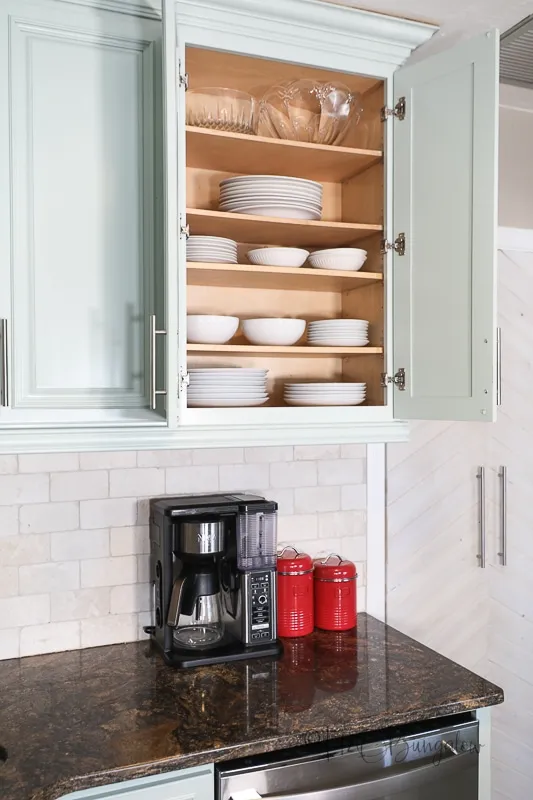
Step 4: Plan Your Kitchen Zones
I create efficiency by establishing zones based on activities: cooking zone, food prep zone, cleaning zone, and food storage zone. Map these zones before putting anything away.
Your cooking zone should be near the stove, food prep near counter space, cleaning zone around the sink, and food storage near your refrigerator or pantry area1.
| Kitchen Zone | What Goes Here | Cabinet/Drawer Location |
|---|---|---|
| Cooking Zone | Pots, pans, cooking utensils, spices, oils | Near stove/oven |
| Food Prep Zone | Cutting boards, mixing bowls, measuring tools | Near largest counter space |
| Cleaning Zone | Dish soap, scrubbers, towels, cleaning products | Under/around sink |
| Food Storage | Food containers, wraps, bags | Near refrigerator |
Step 5: Implement Storage Solutions
I’ve found that the right organizers make all the difference. Install pull-out shelves in deep cabinets to eliminate lost items in the back. Use drawer dividers to separate utensils and tools.
Add shelf risers to maximize vertical space. Consider specialized organizers for lids, cutting boards, and bakeware to optimize every inch.
Step 6: Put Everything in Its Place
Now I carefully place each item in its designated spot according to my zone plan. I make sure the things I use daily are at eye level or in easy-to-reach drawers, while items used only occasionally go in higher cabinets or lower, harder-to-access spaces.
This step requires patience but creates a system that will serve you well for years.

Step 7: Label and Maintain
I find that labeling shelves, bins, and containers helps everyone in the household maintain the system. Create a simple maintenance routine—spend five minutes each evening resetting the kitchen, and do a quick reorganization check monthly.
This prevents the gradual slide back into disorganization that often happens in busy households.

Strategic Cabinet Zoning: What Goes Where
Now let’s get specific about where to put common kitchen items.
Upper Cabinets: What to Store Here
I reserve upper cabinets for lightweight, frequently used items. The cabinet nearest the dishwasher holds everyday dishes, glasses, and mugs for easy unloading. Cabinets above the coffee station contain coffee mugs and supplies.
Less frequently used serving pieces and specialty glassware go in upper cabinets further from primary work zones.

Lower Cabinets: Optimal Organization
My lower cabinets house heavier, bulkier items. The drawers under the stovetop are perfect for pots, pans, and lids—I use drawer organizers to keep them from nesting or sliding around. Cabinets near the prep area store mixing bowls and food processors.
Deep corner cabinets with lazy Susans work well for less frequently used appliances and specialty cookware.
- STORAGE YOU CAN SEE: Includes 6 removable clear bins with handles so you can find and grab…
- BRINGS THE BACK OF THE CABINET TO YOU: Rotates a full 360° on stainless steel ball bearing…
- NO SLIPS, NO SURPRISES: Soft, non-slip feet won’t damage your cabinets or pantry. Go ahead…
- Updated Design for More Stablity – This adjustable pots and pans organizer under cabinet c…
- 3 DIY Way Tool-free Assembly – Excellent pot organizers inside cabinet for multiple uses; …
- Super Solid & Sturdy Structure – Upgraded heavy-duty iron construction holds your precious…
Drawer Organization Systems That Work
I’ve transformed my kitchen drawers from chaotic junk collectors to functional storage spaces. The drawer closest to the dishwasher contains everyday utensils in a divided organizer.
Nearby drawers hold cooking utensils, organized by type. Deeper drawers store food storage containers with lids attached to prevent the endless search for matching pieces7.
Check Next: 13 Clever Kitchen Drawer Organisation Ideas: Easy, Affordable, Practical
| Drawer Location | What to Store | Organizing Tools Needed |
|---|---|---|
| Near Dishwasher | Everyday utensils | Utensil dividers |
| Near Stove | Cooking utensils | Heat-resistant organizers |
| Deep Drawers | Pots, pans, storage containers | Drawer dividers, pan organizers |
| Small Drawers | Spices, kitchen gadgets | Spice inserts, small compartment dividers |
Organizing Kitchen Cabinets in a Small Kitchen
When space is limited, I get creative with every square inch of cabinet space.
Maximize Vertical Space
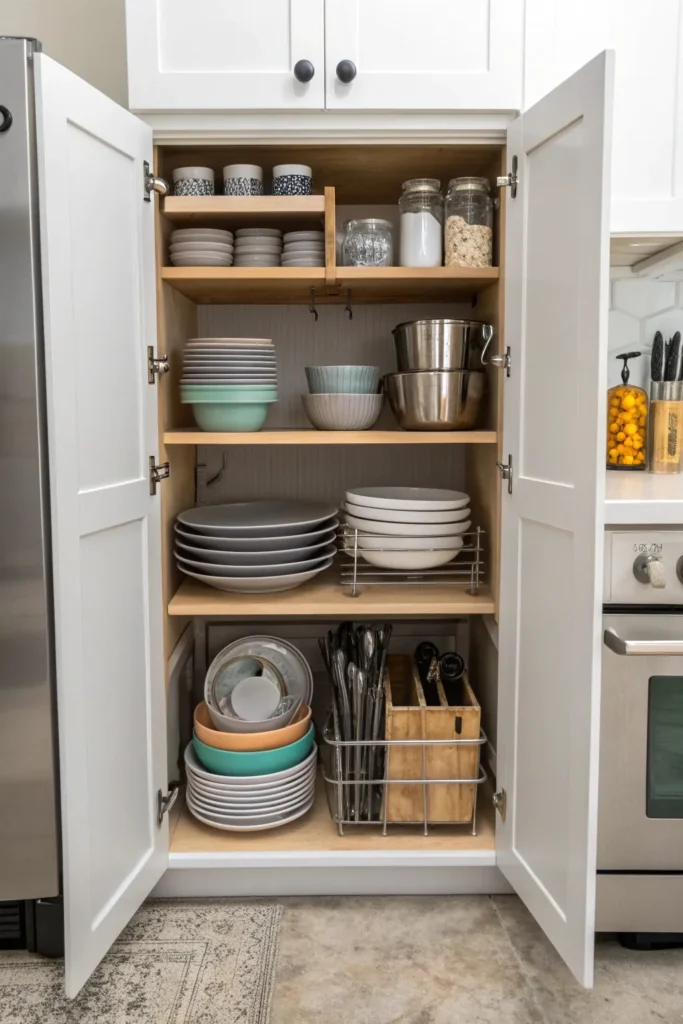
I install shelf risers in cabinets to stack plates, bowls, and even some cookware safely. Over-the-door organizers on cabinet doors hold cutting boards, pot lids, or wrap boxes. Command hooks inside cabinet doors can hang measuring cups and small tools. These solutions double usable space without requiring renovation.
Multi-Functional Storage Solutions
I look for items that serve multiple purposes. A pot rack installed under an upper cabinet frees up valuable cabinet space. Magnetic strips can hold knives or metal utensils on walls.
Pegboards inside cabinet doors provide customizable storage for various items. Remember that in small kitchens, every bit of unused space is an opportunity.
Create an Appliance Garage
I’ve found that an appliance garage—a dedicated cabinet with a pull-up or swing door—keeps frequently used appliances accessible but out of sight.
This works perfectly for blenders, toasters, and coffee makers that you use daily but don’t want cluttering your limited counter space. Look for corners or unused vertical space where you might install this handy feature1.
Smart Pantry Cabinet Organization
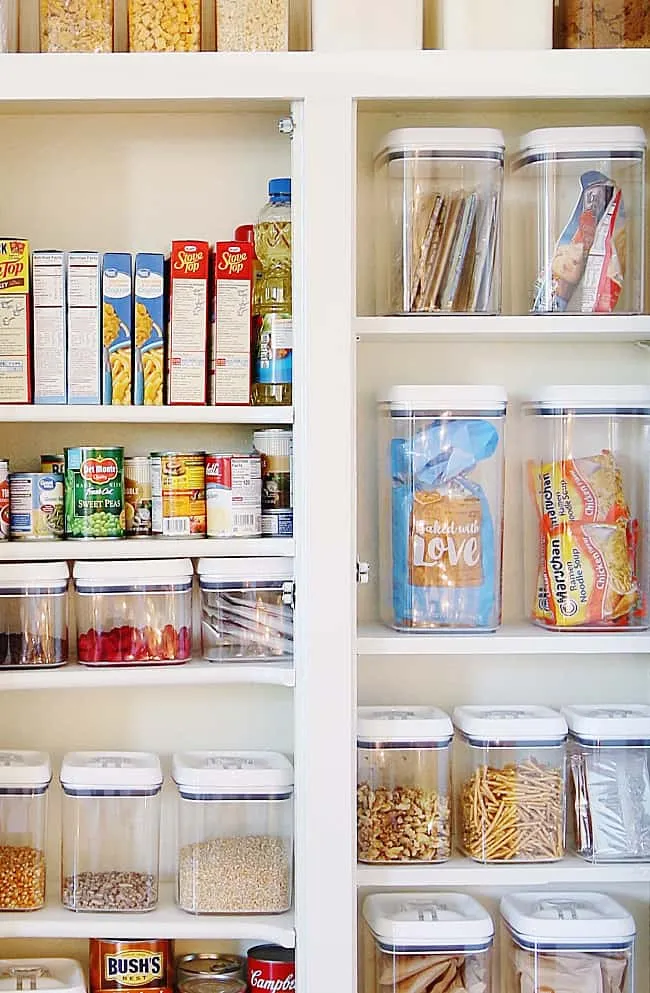
Food storage requires special attention to maintain freshness and visibility.
Categorize and Contain
I group similar pantry items together: baking supplies, breakfast items, pasta and grains, snacks, and canned goods. Clear containers with labels allow me to see what’s inside and how much remains.
This system prevents overbuying and helps maintain inventory. For maximum Pinterest worthiness, choose matching containers in a style that complements your kitchen.
Create Accessible Zones
I place everyday items at eye level, with less frequently used items higher up or lower down. Heavy items always go on lower shelves. I use can risers to see all canned goods at once and lazy Susans for small jars and bottles.
Pull-out drawers or baskets work wonderfully for snacks and produce that doesn’t require refrigeration.
| Pantry Level | What to Store | Recommended Organizers |
|---|---|---|
| Eye Level | Everyday items, frequently used ingredients | Clear containers, lazy Susans |
| Above Eye Level | Seasonal items, bulk supplies, special occasion | Labeled bins, basket organizers |
| Below Eye Level | Heavy items, kid-accessible snacks | Pull-out drawers, sturdy baskets |
| Lowest Level | Potatoes, onions, bulk water | Ventilated baskets, sturdy shelving |
Specialized Storage Solutions
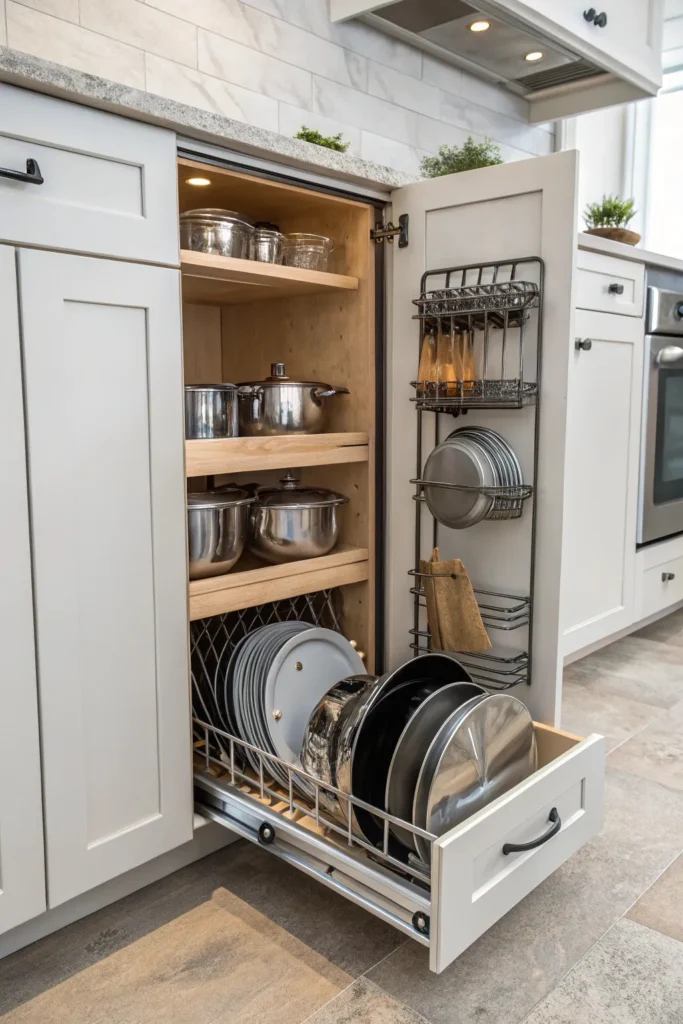
Certain kitchen items present unique storage challenges that require dedicated solutions.
Pot and Pan Organization
I’ve tried many systems, but the most effective is storing pots and pans in deep drawers with dividers. If drawer space is limited, vertical organizers in cabinets work well too. Always store lids separately—either on a door-mounted rack or in a vertical file organizer.
This prevents the frustrating cascade of nested pots that inevitably occurs in stacked storage2.
Spice Storage Systems
I keep spices in a dedicated drawer with angled inserts so labels are visible at a glance. If drawer space is limited, a door-mounted spice rack or a pull-out spice cabinet near the stove works beautifully.
Alphabetical arrangement or organization by cuisine type makes finding what you need quick and easy during meal preparation8.
Smart Solutions for Awkward Spaces
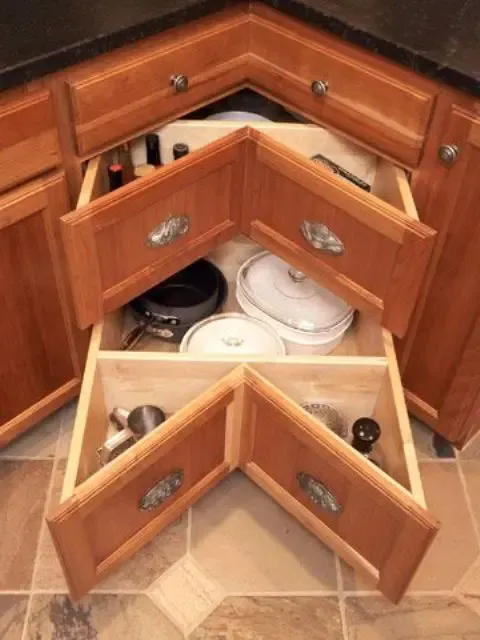
I never waste those tricky corner cabinets or oddly shaped spaces. Corner cabinets transform with lazy Susan installations or special corner drawers.
That awkward space beside the refrigerator becomes a perfect pull-out pantry for canned goods and spices. The narrow cabinet next to the stove holds baking sheets and cutting boards stored vertically.
Must Check Next: 13 Creative Storage Ideas for Awkward Spaces in Kitchen: Maximize Every Inch
Maintaining Your Organized Kitchen
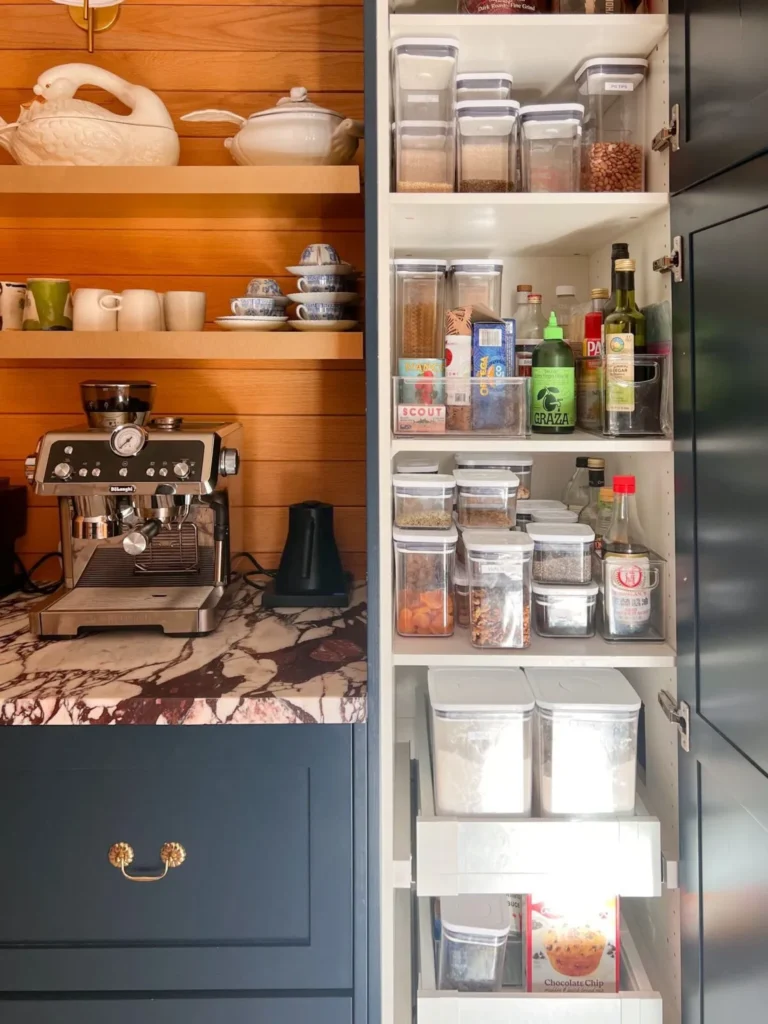
Weekly Reset Routine
I dedicate 15 minutes each weekend to reset my kitchen organization. I check pantry items for anything that needs to be used soon, wipe down cabinet fronts, and make sure everything has returned to its proper place.
This small time investment prevents the need for major reorganization projects down the road.
Seasonal Organization Updates
Four times a year, I rotate seasonal cooking equipment, bringing holiday bakeware forward before festive seasons and storing it away afterward.
I also use these quarterly check-ins to assess what’s working in my organizational system and what might need tweaking. Staying flexible helps accommodate changing needs and new acquisitions.
FAQs: Kitchen Cabinet Organization
Where should dishes and glasses be stored in kitchen cabinets?
I store everyday dishes and glasses in upper cabinets near the dishwasher for easy unloading. Plates and bowls go on lower shelves with glasses above them.
Special occasion dishware can be stored in higher cabinets since they’re accessed less frequently. For families with children, consider keeping everyday kid dishes in a lower cabinet they can reach themselves.
How do I organize my kitchen cabinets if I’m left-handed?
As a left-handed person myself, I recommend reversing traditional kitchen organization. Place everyday dishes to the left of the sink instead of the right. Position cooking utensils to the left of the stove. Essentially, mirror standard kitchen organization advice to match your dominant hand’s workflow. This small adjustment makes cooking much more efficient and comfortable.
What’s the best way to organize under the kitchen sink?
I start by installing a waterproof liner to protect against inevitable leaks. Then I use stackable bins with pull-out functionality—one for cleaning supplies, one for dishwashing items.
A tension rod near the top works perfectly for hanging spray bottles. Always leave space around pipes and avoid overpacking this area so you can quickly address any plumbing issues.
How do I maintain organization with roommates or family members?
I’ve found that clear labeling is essential for shared kitchens. Take photos of properly organized drawers and cabinets and tape them inside the doors as visual guides.
Establish simple systems that everyone can follow, and schedule monthly quick reorganization sessions together. Remember that perfect organization isn’t the goal—functional systems that everyone can maintain are what matter.
What should I do with rarely used small appliances?
I store infrequently used appliances like ice cream makers or specialty cookers in higher cabinets or in designated storage outside the kitchen if space allows.
If you use an appliance less than once a month, it probably doesn’t deserve prime kitchen real estate. Consider creating a seasonal rotation system, bringing appliances forward when they’re likely to be used.
How do I organize a kitchen with very few cabinets?
I maximize vertical space with wall-mounted shelving, magnetic strips, and over-the-door organizers. Consider a rolling cart that provides additional storage and workspace.
Look beyond traditional kitchen boundaries—a nearby closet could become pantry space, or a bookshelf could hold less frequently used items.
Focus on multi-purpose tools that eliminate the need for single-use gadgets.
What’s the best way to organize food storage containers?
I store containers with their lids attached whenever possible to eliminate searching for matching pieces.
For sets with multiple sizes, nest containers and store lids vertically in a separate organizer. Clear containers let you see what you have, while a consistent style creates a cohesive look.
Regular audits help eliminate orphaned pieces and maintain an organized system.
In the End….
Transforming your kitchen cabinets and drawers from chaotic to organized doesn’t happen overnight, but the effort is absolutely worth it.
I’ve found that taking a systematic approach—decluttering first, then carefully planning where each item belongs based on frequency of use and logical workflow—creates a kitchen that’s not just Instagram-worthy but truly functional for everyday life.
Remember that the perfect organization system is one that works for you and your household.
Be willing to adjust and refine as you discover what works best in your space. Start with one cabinet or drawer at a time if the project feels overwhelming.
Before long, you’ll experience the joy of opening a cabinet and immediately finding exactly what you need.
I hope these ideas inspire you to create a kitchen organization system that makes cooking and meal prep more enjoyable.
Your future self will thank you each time you easily locate that specific measuring cup or spice without having to empty an entire cabinet!

